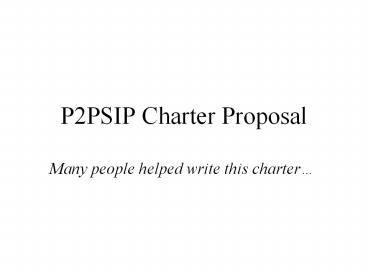P2PSIP Charter Proposal PowerPoint PPT Presentation
Title: P2PSIP Charter Proposal
1
P2PSIP Charter Proposal
- Many people helped write this charter
2
Heading and such
- Peer-to-Peer Session Initiation Protocol
(P2PSIP) - Chairs TBD
- RAI Area Director(s) Cullen Jennings and Jon
Peterson - RAI Area Advisor Cullen Jennings
- Mailing Lists General Discussion
p2p-sip_at_cs.columbia.edu - Subscribe at http//lists.cs.columbia.edu/mailman
/listinfo/p2p-sip - Archive at http//lists.cs.columbia.edu/pipermail
/p2p-sip/
3
Description of the Working Group
The Peer-to-Peer (P2P) Session Initiation
Protocol working group (P2PSIP WG) is chartered
to develop protocols and mechanisms for the use
of the Session Initiation Protocol (SIP) in
settings where the service of establishing and
managing sessions is principally handled by a
collection of intelligent endpoints, rather than
centralized servers as in SIP as currently
deployed. A number of cases where such an
architecture is desirable have been documented in
1. The terminology and concepts draft 2
explains the terms and concepts used here. The
work focuses on collections of nodes called
"P2PSIP peers" and "P2PSIP clients". P2PSIP peers
manifest a distributed namespace in which overlay
users are identified and provides mechanisms for
locating users or resources within the P2PSIP
overlay. P2PSIP clients and peers use the
resolution services of the peers as an
alternative to the SIP discovery process of RFC
3263. Session management, messaging, and presence
functions are performed using traditional SIP.
4
This group's primary tasks are to produce
- An overview document explaining concepts,
terminology, rationale and illustrative use cases
for the remaining work. - A proposed standard defining a P2PSIP Peer
Protocol. This protocol is used between P2PSIP
overlay peers, some of which may be behind NATs.
This protocol will define how the P2PSIP peers
collectively provide for user and resource
location in a SIP environment with no or minimal
centralized servers. This protocol may or may not
be syntactically based on SIP, a decision to be
made by the WG. The group will identify and
require one base P2P algorithm (likely a
particular Distributed Hash Table (DHT)
algorithm), while allowing for additional
optional algorithms in the future. - A proposed standard defining a P2PSIP Client
Protocol for use by P2PSIP clients, some of which
may be behind NATs. This protocol will define how
the P2PSIP clients query and/or modify, the
resource location information of the overlay.
While clearly a logical subset of the P2PSIP
Protocol, the WG will determine if the client
protocol is a syntactic subset of the peer
protocol, and whether the client protocol builds
on the SIP protocol. - An applicability statement. This document will
address how the protocols defined above, along
with existing IETF protocols, can be used to
produce systems to locate a user, identify
appropriate resources to facilitate
communications (for example media relays), and
establish communications between the users,
without relying on centralized servers.
5
Other WGs, NATs, Anonymity
The work planned for the P2PSIP working group is
distinct from, but requires close participation
with other IETF WGs, particularly SIP, SIPPING,
SIMPLE, BEHAVE and MMUSIC. The group cannot
modify the baseline SIP behavior, define a new
version of SIP, or attempt to produce a parallel
protocol for session establishment. If the group
determines that any capabilities requiring an
extension to SIP are needed, the group will seek
to define such extensions within the SIP working
group using the SIP change process (RFC 3427).
Similarly, existing tools developed in the BEHAVE
and MMUSIC groups will be used for NAT traversal,
with extensions or changes desired to support
P2PSIP created in these groups.The working
group takes it as a fact that NATs and firewalls
exist in the Internet, and will ensure that the
protocols produced work in their presence as much
as possible. Similarly, the group will attempt
not to make design decisions that preclude
anonymous communications systems from being
crafted using the protocols defined by this WG.
6
Excluded Topics
- The following topics are excluded from the
Working Group's scope - Issues specific to applications other than
locating users and resources for SIP-based
communications and presence. - Solving "research" type questions related to
P2PSIP or P2P in general. The WG will instead
forward such work to the IRTF P2PRG or other RG
as appropriate. Examples include fully
distributed schemes for assuring unique user
identities and the development of P2P-based
replacements for DNS. - Locating resources based on something other than
URIs. In other words, arbitrary search of
attributes is out of scope, but locating
resources based on their URIs is in scope. Using
URIs need not imply using the DNS or having a
record in the DNS for the URI. - Multicast and dynamic DNS based approaches as the
core lookup mechanism locating users and
resources. These techniques may be in-scope for
locating bootstrap peers/servers or for
interoperation with traditional SIP.
7
Goals and Milestones
Sep 2007 Submit P2PSIP overview document to the
IESG (Informational)Sep 2008 Submit P2PSIP
overlay client protocol document to the IESG
(Standards track)Sep 2008 Submit P2PSIP overlay
peer protocol document to the IESG (Standards
track)May 2009 Submit P2PSIP applicability
statement to the IESG (Standards track)
References1 D. Bryan, E. Shim, B. B.
Lowekamp, "Use Cases for Peer-to-Peer Session
Initiation Protocol (P2PSIP)", draft-bryan-sipping
-p2p-usecases (work-in-progress)2 D. Willis,
D. Bryan, P. Matthews, E. Shim, "Concepts and
Terminology for Peer to Peer SIP,
draft-willis-p2psip-concepts (work-in-progress)

